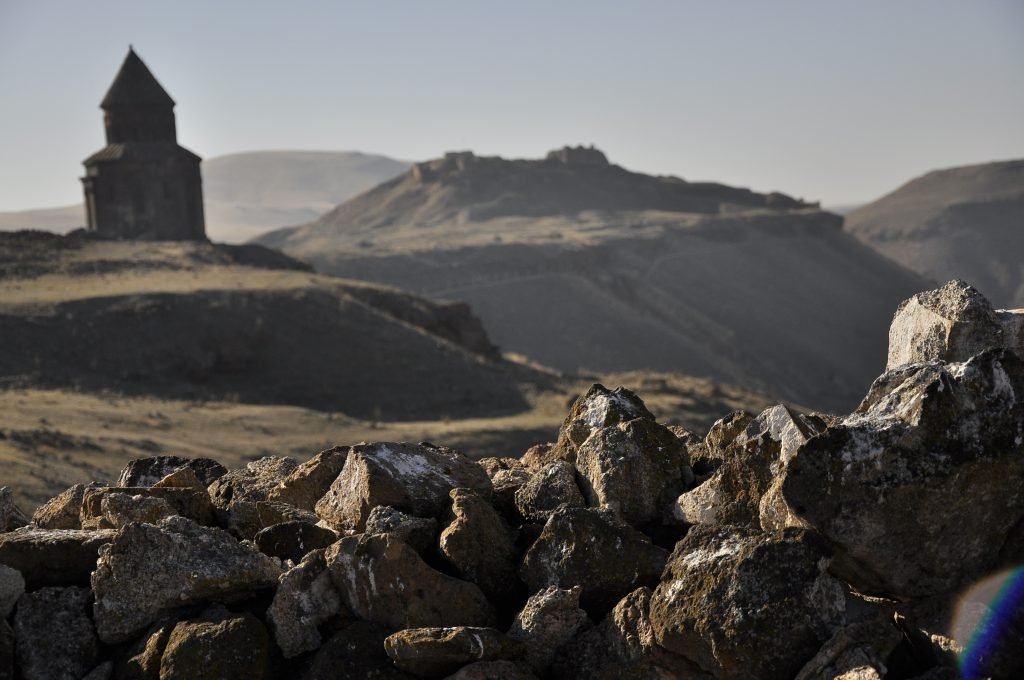ISTANBUL, Turkey (A.W.)—The United Nations Educational, Scientific, and Cultural Organization (UNESCO) World Heritage Committee inscribed five new sites to its World Heritage List—including the historic archaeological site of Ani—during its 40th session taking place in Istanbul on July 10-20.

According to a press statement released by the committee on July 15, the other newly inscribed sites are in Greece (archaeological site of Philippi); Spain (Antequera Dolmens site); the United Kingdom (Gorham’s Cave Complex); and a trans-boundary site located in Croatia, Montenegro, Serbia, and Bosnia and Herzegovina (Stećci medieval tombstones graveyards).
The press statement lists the historic archaeological site of Ani as a “medieval city [that] combines residential, religious, and military structures, characteristic of a medieval urbanism built up over the centuries by Christian and then Muslim dynasties.”
In its description, the World Heritage Committee states that Ani flourished in the 10th and 11th centuries CE, when it became the capital of the medieval Armenian Kingdom of the Bagratides and “profited from control of one branch of the Silk Road.” It also cites the Mongol invasion and the devastating earthquake of 1319 as the “beginning of the city’s decline.”
“Preserving the Medieval City of Ani: Cultural Heritage between Contest and Reconciliation,” an article by Dr. Heghnar Zeitlian Watenpaugh, was published in late 2014 in the highly competitive international Journal of the Society of Architectural Historians. Watenpaugh is co-chair of the Department of Art and Art History at the University of California, Davis (UCD), where she specializes in urban and architectural art history in Islamic societies. The article, in Watenpaugh’s words, “…provides a comprehensive history of archaeology, preservation, and heritage management at Ani. It examines the current preservation campaign that is unfolding at Ani and places it in the broader context of cultural heritage preservation in Turkey, and of the challenges posed by Armenian cultural heritage sites in particular.”

In January 2015, Watenpaugh explained that the addition of Ani to the UNESCO World Heritage List would secure significant benefits in protection, research expertise, and funding.
Founded in 1945, UNESCO is a specialized agency of the United Nations whose purpose is to contribute to peace and security by promoting international collaboration through educational, scientific, and cultural reforms in order to increase universal respect for justice, the rule of law, and human rights along with fundamental freedom proclaimed in the U.N. Charter.


This is a welcome development. Of course my preference would be for Armenia to again be sovereign over Ani, as it was as recently as a century ago.
But Ani’s recognition as a World Heritage site is a significant start on the journey of saving this part of our cultural heritage.
Ani is a major chapter in my historical guide to Western Armenia, “Historic Armenia After 100 Years: Ani, Kars, and the Six Provinces of Western Armenia.” http://www.HistoricArmeniaBook.com
Although it is good that Armenian cultural aspects are being recognized by UNESCO, at the same time I feel that UNESCO is a political tool in which they are trying to legitimize fake cultures and fake history at the expense of Armenian culture for the purpose of being “politically correct” and trying to make “all sides” happy.
For example, they listed “carpets in Azerbaijan” instead of Armenia, ignoring the fact that Azerbaijan has no tradition of carpet making beyond a century or so ago. Thus, UNESCO is aiding and abetting false history which Azerbaijan is all too happy to exploit.
The same thing with Armenian harissa, giving that ancient Armenian dish to Turkey, who call it keshkeg. Thus, another false history message giving ‘Turks’ a history in the region which they don’t actually have.
Yet, they gave in to some of the demands with Armenian lavash, and in a few months they might make another ruling that this Armenian bread “belongs to many regions”, namely of course Turkish countries, and apparently Iran is in on this protest, no doubt by “Azeri” Iranians. The next item up that Turks and Azeris want to appropriate from Armenia is dolma.
Turks and Azeris are out to confiscate Armenian culture and history and thereby deny Armenians their own history, and an organization like UNESCO is unfortunately letting them. I am not at all happy about UNESCO. And I also think the diaspora organizations are being too lax on this subject, it seems Armenia is alone in this fight, and it needs to change.
With this act, the final stage of the almost 100-year campaign by Turkey to eliminate Ani as a physical and cultural entity will begin. The superficiality of this article reveal how unopposed the final stage will be. Ani is no longer an Armenian medieval city site, it is a ‘medieval eastern Anatolian’ site in which its Armenian creators and Armenian art play a minor part in a greater multicultural and multiethnic “Anatolia” – this Anatolia includes all of Armenia, and Azerbaijan too. The plan submitted by Turkey to UNESCO will turn Ani into a sort of Disneyland theme park for Turkish and Azeri tourists in which visitors are transported around the site by miniature railway before retiring to a shopping plaza built on the site of Ani village (which will be demolished) where they can purchase Seljuk artwork and craft souvenirs and watch multimedia presentations on Ani’s Anatolian Turkish history.
I agree with Steve’s remarks. A Disneyland-style theme park will bring in more tourist money for Turkey without enhancing archeological digs and proper restoration …witness the millions of tourists pouring into Pompeii and degrading the site. Incorrect/generalized attributions are also a continuing concern…witness description of items displayed by a respectable institution such as the British Museum!!!